Executive Summary
No one wants to pay any more in taxes than they have to, and Judge Learned Hand is famous for stating that, “Anyone may arrange his affairs so that his taxes shall be as low as possible.” Which, in practice, usually entails engaging in tax strategies that minimize (or at least defer) taxes as long as possible. Except the caveat is that when it comes to tax deferral, there really is such thing as being “too good” at doing so, given the progressive nature of income tax brackets (with higher tax rates on higher income levels). For instance, the tax-deferred retirement account that grows so large that, when Required Minimum Distributions begin, the retiree is thrust into a tax bracket higher than he/she ever faced during the accumulation years (or earlier retirement years) in the first place.
Accordingly, the reality is that sometimes the best way to arrange affairs to minimize taxes is actually not to defer them, and instead accelerate the income. With the caveat that if too much income is accelerated, the individual may simply drive themselves into higher tax brackets today, finishing with less wealth than they would have if they simply relied on good old-fashioned tax deferral instead!
Thus, the optimal balancing point really is a balancing point between the two – seeking out an equilibrium rate that accelerates enough income to fill up lower tax brackets today, but still defers enough income to fill up the tax brackets in the future as well. Or what are actually two tax rate equilibria – one for ordinary income (and its 7 tax brackets), and a second for long-term capital gains and qualified dividends (which have their own 4 tax brackets, and stack their income on top of ordinary income).
And while it can be difficult to know for certain what future tax rates will be, the very nature of doing financial planning (and especially retirement projections) is to determine the current trajectory of wealth… which means with some relatively simple and straightforward assumptions about future Social Security and pension payments, RMD calculations, and anticipated interest, dividends, and capital gains, it really is feasible to make a reasonable approximation of an individual’s future tax rates to determine where the ideal equilibrium will be. And then engage in strategies from accelerated retirement account liquidations, to partial Roth conversions, and capital gains harvesting, as necessary to ensure that any currently-lower tax brackets are filled up to reach the equilibrium point.
Ultimately, the ideal tax bracket to fill up will vary by the individual and their overall wealth and circumstances, with many retirees (even millionaires) able to remain in the 12% ordinary income bracket (and 0% capital gains rates) with proactive planning, while more affluent retirees may aim for the 22% or 24% brackets and the 15% capital gains rate, and the wealthiest households may seek out any tax rate equilibrium that is not the top tax bracket (as anything lower than the top bracket is a relative improvement!).
The fundamental point, though, is simply to understand that the best way to plan around taxes in retirement is not to defer too much income, nor too little, but to seek out and find the equilibrium rate that balances them out!
Finding Your Tax Equilibrium Rate In Retirement
One of the most fundamental reasons for saving and investing is to accumulate enough assets to achieve a point of “financial independence,” where there’s no longer any need to work for income, and instead, the individual can support themselves solely from their available assets and other retirement resources.
The caveat, however, is that accumulating substantial wealth can potentially accumulate significant tax consequences to go with it. Not only because sometimes highly appreciated investments produce very significant capital gains taxes (e.g., in the case of selling a business, or simply a concentrated investment position in grew substantially over the years), but also due to the fact that much of our savings today are placed into tax-deferred retirement accounts… which are favorable as long as the money stays in the account and the taxes are deferred, but can become very problematic when it’s time to actually begin withdrawing from and liquidating the account (and the taxes come due).
In fact, one of the fundamental problems of tax-deferred retirement accounts, in particular, is that there’s actually such thing as being “too good” at tax deferral… where tax rates are modest for years (or even decades) thanks to the tax-sheltering of the retirement account itself, but then when it’s time to take retirement withdrawals (or distributions are mandated by Uncle Sam’s Required Minimum Distribution obligation at age 70 ½), suddenly so much taxable income spills out of the retirement account at once that the retiree is vaulted into drastically higher tax brackets, never to see lower tax rates again as a tidal wave of pre-tax income comes due. At which point the retiree can only look back fondly on those earlier years when tax rates were lower… but now unable to actually use those lower tax brackets anymore! Because the lower tax bracket “buckets” were use-it-or-lose-it opportunities that have already passed.
Of course, pre-tax retirement contributions can be made to a Roth IRA instead of a traditional IRA – or alternatively, the traditional retirement account can be converted to a Roth – in order to avoid the build-up of tax-deferred income in the future. Except doing so by definition accelerates what might have been a distant future tax liability up to the present, as Roth contributions are made with after-tax dollars (and Roth conversions trigger immediate taxation). And if the Roth conversion itself is large enough, the individual can propel themselves into even higher tax brackets immediately than they ever would have paid in the future anyway!
As a result, the optimal strategy for managing tax-deferred growth, and the potentially substantial build-up of pre-tax assets (from unrealized capital gains to traditional IRAs and 401(k) plans), is to defer enough to avoid high tax rates now, but not so much as to cause much higher tax rates in the future. In essence, it’s about finding the equilibrium point – like the balancing point on a seesaw – where enough income is created or recognized now to avoid “too much” in the future, but not so much is drawn into the present that it would have been better to just defer the income and wait until later when tax rates might have been lower!
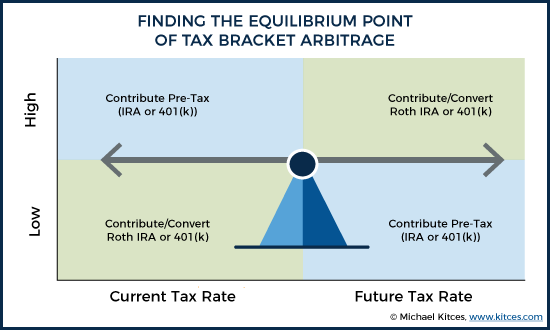
Or viewed another way, the benefit of finding the tax bracket equilibrium point is itself a form of “tax bracket arbitrage” – where income that will be taxed someday is shifted from higher-tax-rate years into lower-tax-rate years, without changing the underlying nature of the income (or risk of the investments) themselves, just where/how they’re held for tax purposes.
Determining Your Equilibrium Tax Rate And Projecting Retirement (Taxable) Income
While the basic principle of finding a tax rate equilibrium is fairly straightforward – just create enough in Roth-style contributions or conversions, or other taxable events, to fill the lower tax brackets now, without pushing higher than what tax rates would have been in the future anyway – in practice, the determination is more complex, because where that equilibrium point lies will vary depending on an individual’s current and projected wealth and how that compounding wealth will itself cause more taxable income (and potentially higher tax rates) in the future.
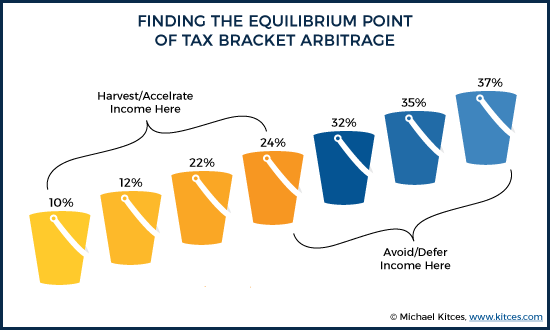
As while it’s relatively straightforward to determine someone’s marginal tax rate today, by projecting out their known (or reasonably-approximated) income and expenses for the year to know what the tax rate would be on the next dollar of Roth contribution, Roth conversion, or other taxable income… knowing whether that rate is a “good” deal or not relative to the future requires also projecting out the trajectory of wealth into the future to figure out what that likely future (marginal) tax rate will be.
And the good news is that while some prospective retirees throw their hands up in the air and say, “who knows what the tax rules will be in the future,” the reality is that projecting future tax rates is not really so blind.
The starting point is to count known future income streams first, including most notably Social Security benefits (and whether the maximum 85% of benefits will be included in income for tax purposes), along with any other fixed income streams like pensions or (lifetime immediate) annuity payments.
Second, add on any anticipated distributions from those pre-tax retirement accounts, from the distributions required to cover retirement spending itself, to the onset of Required Minimum Distributions when they will begin at age 70 ½.
Third, project out the accumulation of (taxable) investment accounts, recognizing the contribution that they too will make to annually taxable income, in the form of passive interest and dividends, along with at least some assumption for capital gains (as there will typically be at least some portfolio turnover, either to generate retirement cash flows, due to occasional investment changes over time as markets and opportunities change, or simply for rebalancing purposes).
Notably, not all of the income considered for the projection of future tax rates will necessarily be income that the retiree needs for retirement spending purposes. While a lot of sufficient taxable accounts to fund retirement spending will cause some withdrawals from pre-tax retirement accounts eventually, Required Minimum Distributions almost by definition are forced withdrawals for tax purposes that weren’t needed for cash flow purposes (or the retiree would have already been taking enough withdrawals to satisfy the RMD obligation). And taxable accounts will produce whatever interest, dividends, and capital gains they produce from time to time, which may or may not bear much relationship to what’s needed (just) to cover retirement spending. In other words, the point is not to project “spending income” (i.e., cash flow distributions), but taxable income instead (i.e., literally, income for tax purposes, regardless of whether/how it will be spent at the time!).
Example 1. Samuel and Diane are both 62, getting ready to retire, and have accumulated nearly $1.3M in savings for retirement, including a $400,000 taxable account, $700,000 in a traditional rollover IRA, and $200,000 in a Roth IRA. Between the two of them, they are eligible for nearly $34,000/year in Social Security benefits if they start now (at age 62), but have decided to wait until age 70 when their benefit will be increased to almost $64,000/year (plus cost-of-living adjustments). In addition, Diane will receive a teacher’s pension of nearly $20,000/year (but with no annual inflation COLA).
The couple’s goal is to spend $8,000/month in retirement ($96,000/year), which will be almost entirely covered by Diane’s pension plus their Social Security benefits at age 70 (at least, before taxes are considered) totaling $84,000/year. However, the couple must plan for the lack of inflation adjustments on Diane’s pension (as with inflation, their $96,000/year living will be up to more than $120,000/year in 8 years, while their combined inflation-adjusted Social Security and non-inflation-adjusted pension will be only $100,000/year), and the substantial $76,000/year shortfall to cover their spending between now and age 70 when Social Security begins.
The good news is that in the aggregate, the couple should have more than enough in assets to cover their retirement needs. However, their tax situation will be very volatile – with several years of relatively low income through their 60s, followed by much-higher taxable income in their 70s once both Social Security and their RMDs begin from their IRAs.
The couple’s initial plan is to draw $50,000/year from their taxable account for the next 8 years (largely depleting it) and supplement with $25,000/year from their Roth IRA (which will mostly deplete the account as well). In the meantime, the taxable account is projected to produce just about 3%/year in bond interest from the $300,000 invested in bonds, and 8%/year in qualified dividends and capital gains (on average at least) from their $100,000 in stocks. (For asset location purposes, the bulk of their remaining equities are in retirement accounts.) Once they turn age 70, though, their Social Security payments of nearly $80,000/year (adjusted for inflation by then) will begin, on top of RMDs that by then are projected to be nearly $50,000/year (with an 8%/year growth rate on their otherwise-untouched IRA), which provides more than enough cash flow to support their retirement spending at that time.
Thus, while the couple’s spending would be (by intentional design) $96,000/year and adjusting for inflation, the couple’s taxable income profile in the coming years would be approximately as shown below.
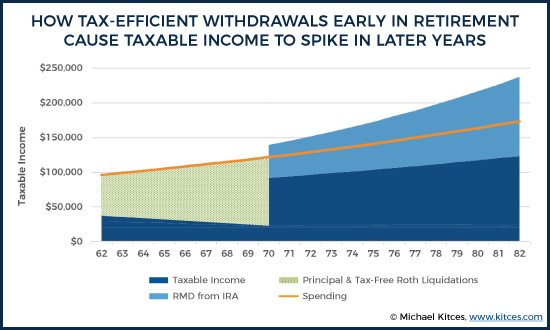
As the chart above shows, while the intended liquidation plan may literally be very tax efficient, particularly in the early years, it is arguably a little too tax-efficient, relying heavily on principal liquidations and just a small portion of taxable income in the early years, followed by a significant increase in taxable income as Social Security benefits begin (and are 85% taxable), on top of then-significant required minimum distributions.
In fact, with a Standard Deduction of $24,000 in 2018, the couple would be eligible for the lowest 10% tax bracket on most of their income from age 62 to 70, including a 0% rate on long-term capital gains and qualified dividends… and then when their Social Security and RMDs begin, they’re thrust up into the 22% tax bracket, from which they never leave!
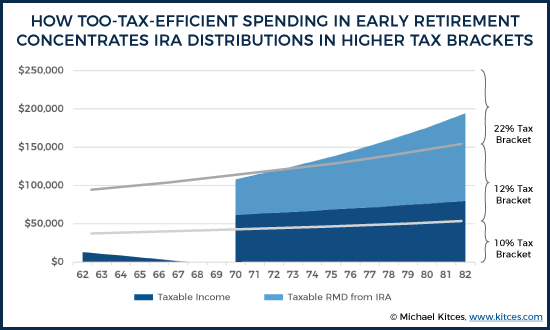
As the above example reveals, while Samuel and Diane will be in a very low tax bracket for the next 8 years, they won’t actually benefit from those lower tax rates, because none of their IRA income is actually subject to those low tax rates! Instead, their low tax brackets are “wasted” in the early years, while their income spikes to higher levels in the later years because they are deferring too much.
Of course, the couple’s exact income won’t likely perfectly align to the projections, given both the potential for changes in interest rates and yields, volatility of capital gains, and uncertainty of returns themselves. Nonetheless, simply projecting known income and “reasonable” growth and income expectations into the future makes it clear that the couple is materially below the threshold for the 22% tax bracket today, and will be materially above it after they turn age 70 and begin both Social Security benefits and Required Minimum Distributions. Suggesting their current tax plan is very much not in equilibrium!
Filling Up The Tax Brackets To Your Equilibrium Tax Rate In Retirement
So what should retirees do when their projected taxable income in retirement doesn’t cleanly align to the projected tax brackets? Shift income around from the high-income years into the low-income years!
As noted earlier, this can be done with any combination of “income-creating” strategies, including:
- Change The Retirement Account Being Contributed To. For those still working, consider changing the retirement contribution from traditional (pre-tax) to Roth if the current tax bracket is lower than it’s projected to be in the future. Or alternatively, shift from Roth contributions to traditional IRA or 401(k) contributions if it would actually be better to claim the deductions now (at high tax rates during the working years) and recognize the income later (in retirement, after wages are gone).
- Take “Unnecessary” Retirement Distributions. While the classic “rule of thumb” for account sequencing in retirement is to spend from the taxable accounts first and just let the pre-tax retirement accounts grow, as shown in the earlier examples, this isn’t always optimal and can result in retirement accounts that compound “too” large, thrusting the retiree into higher tax brackets by the time those retirement distributions actually begin. The alternative? Don’t wait so long to begin distributions from pre-tax accounts! Instead, choose to take withdrawals earlier, even when not required (as RMDs), in order to fill lower tax brackets now and reduce exposure to higher tax brackets later.
- Begin Making (Partial) Roth Conversions. For those who otherwise have sufficient (non-retirement-account) resources to make the necessary liquidations to generate the cash needed for retirement spending (or for those who haven’t even retired yet and don’t need the dollars), another appealing option to shift income across the years is to engage in (partial) Roth conversions. Not to convert the entire retirement, which would both drive the individual into higher tax brackets immediately (not likely better than just waiting until the future), and completely eliminate future retirement-account income (potentially making future tax brackets so low it would have been better to not convert!). But simply to engage in partial Roth conversions each year, using just enough to fill the lower current tax brackets, without crossing into higher ones (while still whittling down future tax exposure).
Example 2. Continuing the prior example, Samuel and Diane decide to fill the gap on their low-income years and achieve tax rate equilibrium throughout retirement by doing partial Roth conversions of $60,000/year for the next 8 years, keeping them within the 12% tax bracket (without rising up to the 22% bracket), and whittling down their IRA to the point that once their Social Security payments begin, there is very little left of their IRA, and they are able to remain in the 12% tax bracket in the future, even when their RMDs begin!
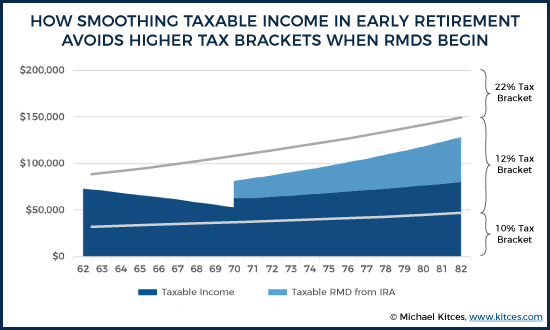
As the above example shows, the net result of finding Samuel and Diane’s tax equilibrium is significant: they save the 10% tax rate difference (between the 22% future and 12% current tax brackets) on most of their $700,000 IRA (plus growth) withdrawals for the rest of their lives as those withdrawals occur over time, saving literally $10s of thousands of dollars in cumulative taxes!
Topping Up The Capital Gains Tax Rate Equilibrium
While the primary focus thus far has been finding the right tax rate equilibrium in retirement, the reality is that there are actually two tax rate equilibria – one for ordinary income, and a second for long-term capital gains (and qualified dividends). Because not only are there 7 ordinary income tax brackets, from 10% to 37%, but there are also four effective capital gains brackets – 0%, 15%, 18.8% (including the 3.8% Medicare surtax), and 23.8% - which similarly run the risk of “over-deferring” and causing unnecessarily high future tax rates on capital gains (while failing to use nearer-term lower capital gains rates today).
Technically, the ordering rules for calculating income tax liabilities themselves dictate that ordinary income (and the associated tax brackets) are counted first, and long-term capital gains (and qualified dividends) then sit on top at whatever their applicable rates will be. Which means in practice, even once an optimal ordinary income tax equilibrium rate is determined, it’s still necessary to also determine the long-term capital gains rate equilibrium as well!
Unfortunately, the situation is complicated by the fact that the long-term capital gains tax brackets do not perfectly align with the ordinary income tax brackets (especially starting in 2018 after changes made by the Tax Cuts and Jobs Act), and have their own thresholds for determining the bracket thresholds.
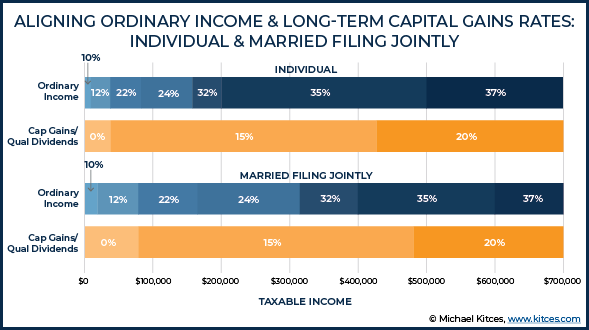
Nonetheless, the point remains that once ordinary income tax brackets are projected (to determine where current and projected future income will fall), it’s necessary to then consider the trajectory of long-term capital gains and qualified dividends and where they may fall as well. Which then may entail other capital loss harvesting (to reduce capital gains in high-rate years), or even engaging in capital gains harvesting to accelerate capital gains into lower-tax-rate years instead!
Example 3. Nick and Carla are both 66 years old, and have a sizable portfolio of $7,000,000, held entirely in a taxable account (the proceeds of selling their family business), alongside a “small” pair of IRAs worth about $800,000.
Their portfolio is invested in a 40/60 conservative growth allocation, resulting in approximately $4.2M held in bonds generating an average yield of $126,000 (3%), and $2.8M in stocks that are producing $56,000/year (2%) in qualified dividends, and an average of $168,000/year (6%) in capital gains turnover. After their seemingly modest Standard Deduction of $24,000 (with few other deductions since they also purchased their retirement home for cash with part of their business sale proceeds), their taxable income is $326,000/year, a blend of ordinary income and long-term capital gains rates. On top of which they’ll be receiving nearly $50,000/year in Social Security benefits, and almost $39,000/year in RMDs beginning in 4 years (at age 70).
In practice, then, Nick and Carla really have two tax rate equilibria to plan around.
The first is based on their ordinary income of $126,000/year (bond interest) + $42,500 (the 85% of their Social Security that is taxable), on top of which they’ll add $39,000/year of RMDs at age 70, reduced by their $24,000 standard deduction. Which means their net ordinary income of $144,500 is enough to keep them in the 22% tax bracket for now, but when their RMDs begin, they will be pushed up into the 24% bracket. And even higher as the growth rate on their wealth just compounds further, given that their goal is to spend “only” about $120,000/year.
The second equilibrium is Nick and Carla’s long-term capital gains and qualified dividend income, which at a combined amount of $224,000/year (projected on average) and stacked on top of their $144,500 of ordinary income, puts them squarely in the middle of the 18.8% tax bracket, with still some room before they hit the top 23.8% capital gains rate (which begins at $479,000 for married couples).
Thus, Nick and Carla can combine strategies, engaging in partial Roth conversions of approximately $25,000/year (which they can do to slightly whittle down their IRA while remaining in the 22% ordinary bracket), and then also harvesting any capital gains in years that they don’t already have them to ensure they’re still filling up the 18.8% capital gains bracket before their compounding wealth drives them into the 23.8% bracket.
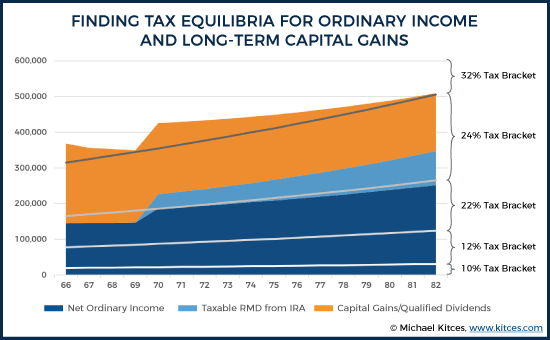
The end result is that Nick and Carla have the opportunity to try to plan around both the 22% (and ultimately perhaps 24%) tax rate equilibrium for their ordinary income in order to future 32%+ tax brackets in the future, and around the 18.8% tax equilibrium for their long-term capital gains and qualified dividends (to avoid ever being pushed into the 23.8% tax bracket).
Finding The Optimal Tax Rate Equilibrium In Retirement
Ultimately, the optimal tax rate equilibrium – or really, two equilibria for both ordinary income and long-term capital gains – will vary by the retiree, depending on his/her income sources and when they begin (e.g., Social Security and pensions), overall wealth, and projected spending (that determines whether wealth in the aggregate will continue to grow and compound towards even higher brackets in the future).
For mass affluent retirees, the optimal equilibrium will likely be the 12% tax bracket, and the highly appealing 0% long-term capital gains tax rate, rather than jumping up to 22% and 15% rates, respectively. As even those with “significant” wealth of $1M or more may still be able to tax-efficiently manage themselves to remain in those brackets, especially if income is proactively managed to ensure they stay in equilibrium (and don’t compound or defer too much income for the future).
For more affluent individuals, “just” staying in the 22% or 24% brackets and avoiding the sizable jump to the 32% tax bracket that kicks in at $157,500 for individuals and $315,000 for married couples filing jointly may be optimal. Notably, this also typically aligns with staying in the 15% long-term capital gains rate and trying to avoid the 3.8% Medicare surtax on capital gains that kicks in at $200,000 of AGI (for individuals, or $250,000 for married couples), recognizing that it may be harder for those couples to avoid in the future given that the 3.8% Medicare surtax threshold is not indexed for inflation.
For the wealthiest households, the ideal tax rate equilibrium may simply be “anything that is not the top tax brackets” of 37% for ordinary income and 23.8% for long-term capital gains. With the caveat, as shown in Example 3, that even households with $7M+ of net worth may actually be nowhere near those top tax brackets. It often takes wealth of $10M or more to actually reach (and remain stuck in) the highest tax brackets. Although for those with significant wealth who aren’t proactively spending (or giving away) all the growth, future compounding may still eventually lift them up to the top tax brackets.
The bottom line, though, is simply to understand that there really is such thing as being 'too good' at tax deferral, but that the solution isn’t necessarily to go all tax-free (e.g., with all Roth accounts and Roth conversion) now instead, which just subjects income to higher tax rates immediately. Instead, the ideal goal is to balance current and future tax rates, finding the optimal equilibrium point that allows retirees to avoid higher tax rates in the future, without unnecessarily increasing their tax costs today!




